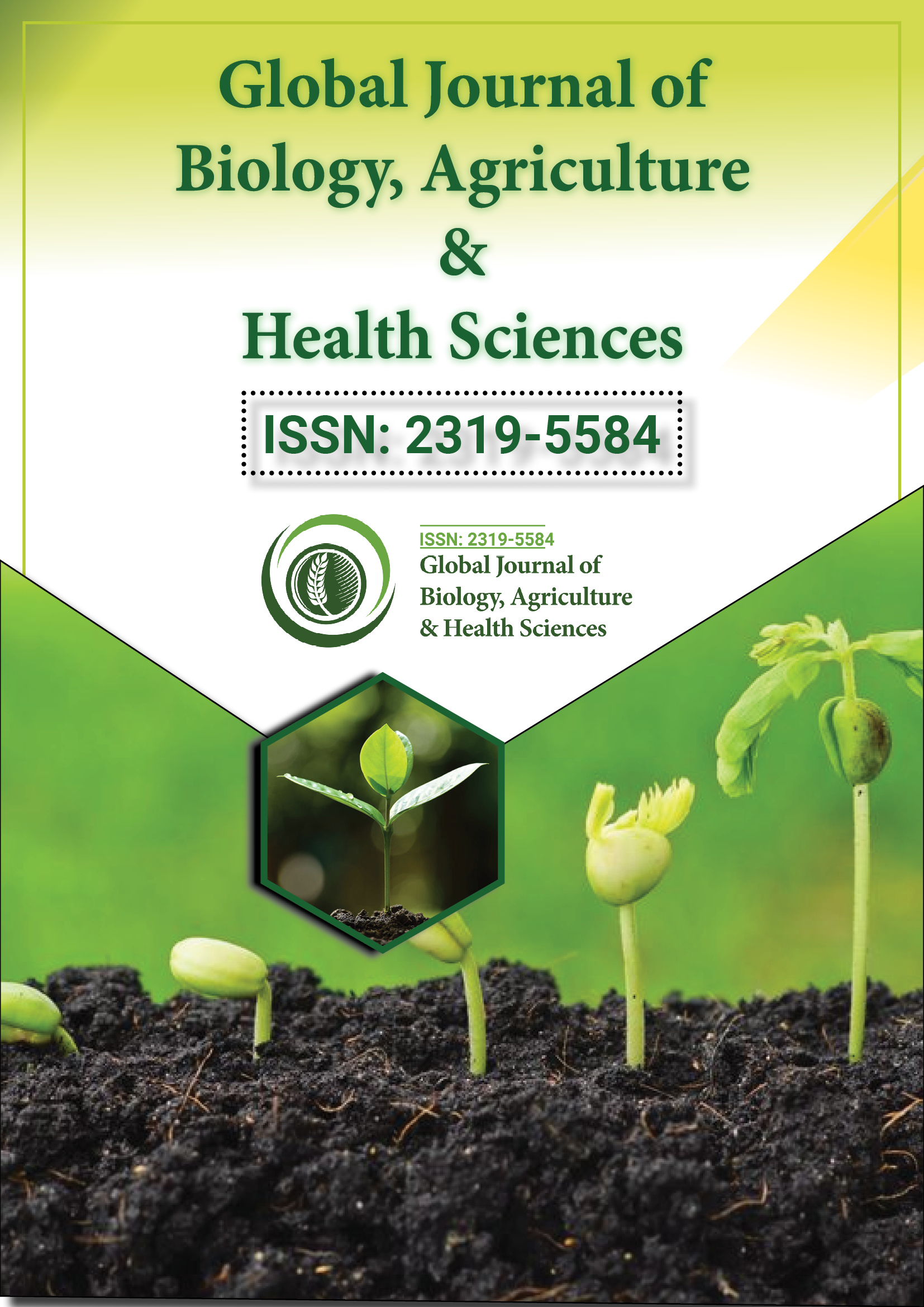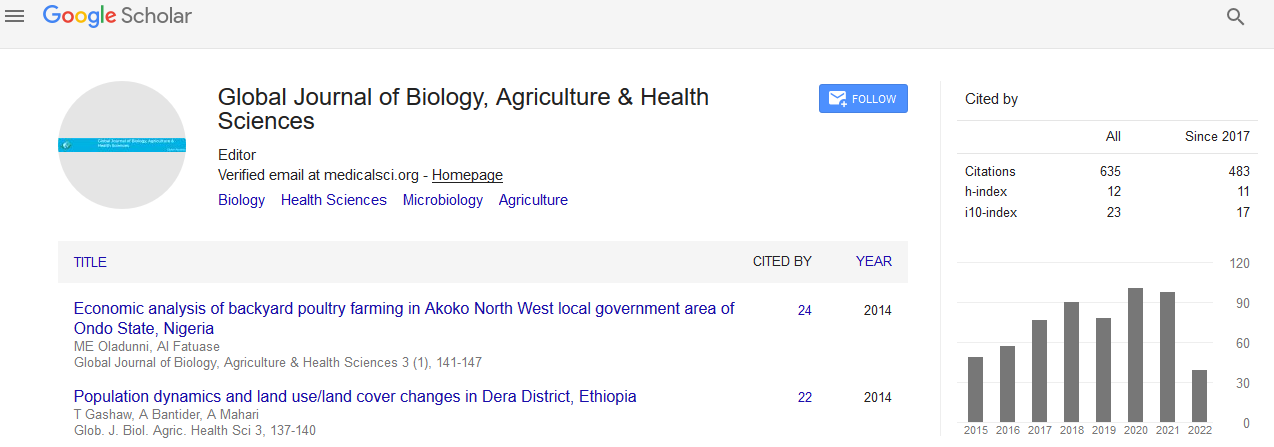Indexed In
- Euro Pub
- Google Scholar
Useful Links
Share This Page
Journal Flyer

Open Access Journals
- Agri and Aquaculture
- Biochemistry
- Bioinformatics & Systems Biology
- Business & Management
- Chemistry
- Clinical Sciences
- Engineering
- Food & Nutrition
- General Science
- Genetics & Molecular Biology
- Immunology & Microbiology
- Medical Sciences
- Neuroscience & Psychology
- Nursing & Health Care
- Pharmaceutical Sciences
Short Communication - (2025) Volume 14, Issue 1
Integrating Ecological Science into Biodiversity Conservation Efforts
Czopik Atkins*Received: 24-Feb-2025, Manuscript No. GJHABS-25-29190; Editor assigned: 26-Feb-2025, Pre QC No. GJHABS-25-29190 (PQ); Reviewed: 12-Mar-2025, QC No. GJHABS-25-29190; Revised: 19-Mar-2025, Manuscript No. GJHABS-25-29190 (R); Published: 26-Mar-2025, DOI: 10.35248/2319-5584.25.14.238
Description
Biodiversity conservation is a critical scientific and social endeavor aimed at protecting the variety of life on Earth, including the diversity of species, ecosystems, and genetic resources. Biodiversity, often referred to as the “web of life,” underpins the functioning of natural systems and provides essential services that support human well-being, such as clean air and water, food security, medicine, and climate regulation. The rapid loss of biodiversity driven by human activities poses serious threats to ecosystem stability, resilience, and sustainability, making conservation efforts vital for maintaining ecological balance and the planet’s health.
Biodiversity encompasses three primary levels: genetic diversity, species diversity, and ecosystem diversity. Genetic diversity refers to the variation within species, providing the raw material for adaptation and evolution. Species diversity represents the variety of species within a habitat or the entire planet. Ecosystem diversity pertains to the range of habitats, communities and ecological processes. Effective biodiversity conservation addresses all these levels, recognizing their interdependence and collective importance.
Conservation strategies fall into two broad categories: in situ and ex situ conservation. In situ conservation focuses on protecting species within their natural habitats. This approach includes the establishment and management of protected areas such as national parks, wildlife reserves, and marine sanctuaries. Protected areas safeguard critical habitats and provide refuge for threatened species, enabling natural processes to continue with minimal human interference. Landscape level conservation efforts promote connectivity between habitats through wildlife corridors and buffer zones, facilitating gene flow and species movement [1-5].
Community-based conservation is a form of in situ conservation that involves local people in managing natural resources. Recognizing that indigenous and local communities often possess traditional ecological knowledge, this approach integrates conservation with sustainable livelihoods. It empowers communities to protect their environments while benefiting economically, fostering stewardship and reducing conflicts between human needs and conservation goals.
Biodiversity conservation also relies heavily on legal and policy frameworks at local, national, and international levels. Treaties such as the Convention on Biological Diversity (CBD) and the Convention on International Trade in Endangered Species (CITES) provide guidelines and commitments for member countries to protect biodiversity and regulate the trade of wildlife. National laws establish protected area networks, regulate hunting and harvesting, and enforce environmental standards. Policy instruments such as environmental impact assessments, land use planning, and payment for ecosystem services promote conservation-friendly development [6-10].
Science and technology play pivotal roles in biodiversity conservation. Ecological research improves understanding of species’ needs, population dynamics, and ecosystem interactions. Geographic Information Systems (GIS) and remote sensing enable monitoring of habitats and land-use changes over time. Molecular techniques help assess genetic diversity and identify species, even from small tissue samples. Conservation genetics informs breeding programs and population management to maintain healthy gene pools. Citizen science initiatives engage the public in data collection, increasing awareness and expanding monitoring efforts.
Conclusion
Biodiversity conservation is essential for maintaining the health of the planet and ensuring human survival and prosperity. By protecting genetic, species, and ecosystem diversity, conservation efforts sustain ecosystem services and resilience. Combining in situ and ex situ strategies, supported by science, policy, and community engagement, provides the best chance to halt biodiversity loss. As the global community faces environmental and social challenges, investing in biodiversity conservation is a critical pathway to a sustainable and equitable future for all life on Earth.
References
- Anand A, Arkin A, Dukes F, Mageeney C, Mukundan H, Mutalik V. Bridging the gap: Pathway programs for inclusion and persistence in microbiology. Trends Microbiol. 2025.
[Crossref] [Google Scholar] [PubMed]
- Akob DM, Oates AE, Girguis PR, Badgley BD, Cooper VS, Poretsky RS, et al. Perspectives on the future of ecology, evolution, and biodiversity from the council on microbial sciences of the American society for microbiology. Msphere. 2024;9(11):e00307 -324.
[Crossref] [Google Scholar] [PubMed]
- Polo JM, Sanchez JL, Arca-Suarez J, Estella A, Gonzalez P, Blasco M, et al. The importance of antimicrobial strategies associated with clinical cure and increased microbiological eradication in patients with complicated urinary tract infections and high risk of relapse. Euro Urol Open Sci. 2025;71:165-171.
[Crossref] [Google Scholar] [PubMed]
- Mariana C, Olivier P, Christian TL, Patricia MG, Francesco AT, Antonio GP, et al. Current microbiological testing approaches and documented infections at febrile neutropenia onset in patients with hematologic malignancies. Int J Infect Dis. 2024;147:107183.
[Crossref] [Google Scholar] [PubMed]
- Akinsemolu A, Onyeaka H. Application of green microbiology for microplastic remediation: Current progress and future perspectives. Environ Adv. 2024, 100569.
- Olbrich L, Franckling-Smith Z, Larsson L, Sabi I, Ntinginya NE, Khosa C, et al. Sequential and parallel testing for microbiological confirmation of tuberculosis disease in children in five low-income and middle-income countries: A secondary analysis of the RaPaed-TB study. Lancet Infect Dis. 2024.
[Crossref] [Google Scholar] [PubMed]
- Fernandes AB, Pereira CF, Pereira HM, Batista MA, Dionisio LF, Alfieri AA, et al. Validation of immersion pre-cooling and drip sanitation standard operating procedures on weight, temperature, microbiological quality, and safety of chicken carcasses. J Food Prot. 2025;100451.
[Crossref] [Google Scholar] [PubMed]
- Teotia AK, Chauhan AS, Thota P, Kumari B, Verma O, Phathak C, et al. Engineering advances in safe laboratory design for pharmaceutical microbiology and assessment of their biohazard risk measures. Saf Sci. 2024;174:106458.
- Culbreath K, Hemarajata P, Thomson Jr RB, Yee R. A day in the life of a medical microbiology director: Navigating the diverse duties as a clinical conductor. Clin Microbiol Newsl. 2024.
- Fujihara T, Matsuo H, Yamamoto G, Sunada A, Hamaguchi S, Onozuka D, et al. Accuracy of odor-based microorganism identification by microbiological technologists with different years of experience: A cross-sectional study. Heliyon. 2024;10(16).
[Crossref] [Google Scholar] [PubMed]
Citation: Atkins C (2025). Integrating Ecological Science into Biodiversity Conservation Efforts. Glob J Agric Health Sci. 14:238.
Copyright: © 2025 Atkins C. This is an open-access article distributed under the terms of the Creative Commons Attribution License, which permits unrestricted use, distribution and reproduction in any medium, provided the original author and source are credited.

